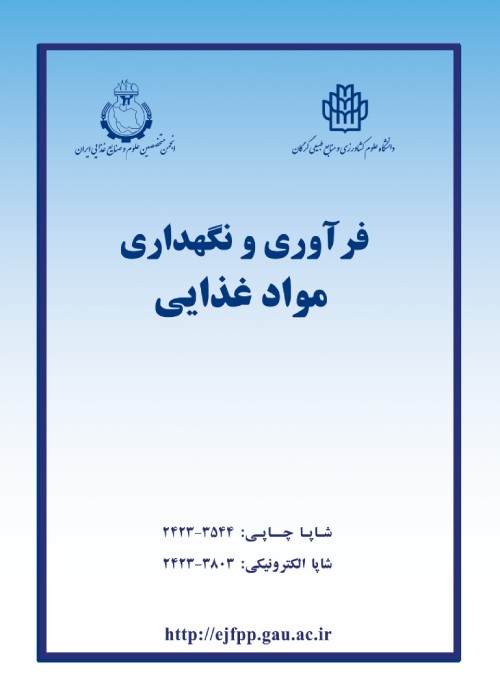Impact of addition of milk powder and microbial transglutaminase on the sensory and textural properties of set yogurt
Author(s):
Article Type:
Research/Original Article (دارای رتبه معتبر)
Abstract:
Background and objectives
Proteins are one of the most important compounds that besides nutritional function for human have a crucial role in food texture development. Proteins are the basic structure of acid-induced gels such as yoghurt. The amount of protein interactions and resulted molecular construction determine the textural and strength of a gel. An effective strategy to improve textural properties of food proteins particularly dairy products is enzymatic treatment with transglutaminase (TG). This enzyme with formation of covalent bonds between milk proteins and trap water in protein network produces a stable and smooth gel with higher water holding capacity. Nowadays, in order to improve the yoghurt texture different methods of milk solids enhancement (increasing the milk solids) like addition of milk powder are used. However, these procedures resulted in higher acidity in the product during storage period. Therefore, with using of TG enzyme as a substituted method, not only the yoghurt texture can be improved, but also the reduction of quality of the product during storage time can be prevented.
Materials and methods
Set-type yoghurt samples were manufactured from cow's milk treated with different concentration of microbial TG (0.01, 0.02 and 0.03 percent TG per milk, v/w) and different amounts of dry matter of milk (8 and 9 percent). Yoghurt sample that did not contain any TG was regarded as control. Fresh and stored yoghurts (during 21 days) were evaluated for sensory attributes (appearance, color, odor, texture and taste) and instrumental texture analysis (hardness, consistency, adhesiveness and viscosity index).
Results
Results showed that all variables had significant effects (p<0.05) on studied parameters. In general, except color and taste, other sensory scores usually were affected by the variables, i.e. milk powder addition, transglutaminase treatment and storage period. By increasing the variables levels, particularly increase of enzyme concentration, the appearance and texture of yoghurts were improved. Results also showed that by increasing enzyme concentration and milk solids, the amount of hardness, consistency, adhesiveness and viscosity index were meaningfully increased. In all the yoghurt samples, the hardness and consistency reached to maximum level at the end of 3 weeks’ storage period.
Conclusion
This investigation confirmed that enzymatic cross-linking by transglutaminase might be applied effectively to establish three dimensional structure of yoghurt and to improve texture properties of the product. Although the best samples with the higher textural properties were produced with using 0.03 percent of TG enzyme, but no significant differences with samples containing 0.02 and 0.03 percent was observed. Therefore, for set yoghurt production utilization of 0.02 percent TG enzyme was determined as the best level of TG treatment. Based on our results, effect of addition of 0.01 percent enzyme (one unit) on the textural properties of yoghurt was equal to addition of more than one percent milk solids (milk powder)Keywords:
Language:
Persian
Published:
Electronic Journal of Food Processing and Preservation, Volume:10 Issue: 2, 2018
Pages:
121 to 136
magiran.com/p1937904
دانلود و مطالعه متن این مقاله با یکی از روشهای زیر امکان پذیر است:
اشتراک شخصی
با عضویت و پرداخت آنلاین حق اشتراک یکساله به مبلغ 1,390,000ريال میتوانید 70 عنوان مطلب دانلود کنید!
اشتراک سازمانی
به کتابخانه دانشگاه یا محل کار خود پیشنهاد کنید تا اشتراک سازمانی این پایگاه را برای دسترسی نامحدود همه کاربران به متن مطالب تهیه نمایند!
توجه!
- حق عضویت دریافتی صرف حمایت از نشریات عضو و نگهداری، تکمیل و توسعه مگیران میشود.
- پرداخت حق اشتراک و دانلود مقالات اجازه بازنشر آن در سایر رسانههای چاپی و دیجیتال را به کاربر نمیدهد.
In order to view content subscription is required
Personal subscription
Subscribe magiran.com for 70 € euros via PayPal and download 70 articles during a year.
Organization subscription
Please contact us to subscribe your university or library for unlimited access!


